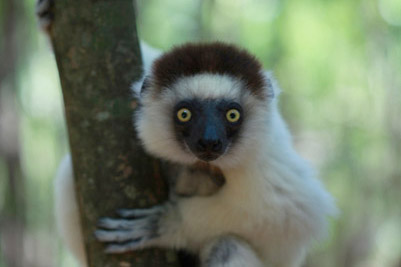According to the most recent IUCN assessment, 48 percent of primates are threatened with extinction. Major threats to primates include habitat loss and fragmentation, hunting, and the wildlife trade.
A new paper published in Tropical Conservation Science looked at ones of these threats — fragmentation — in an effort to determine what traits put primates at highest risk of extinction in forest fragments. Traits investigated all related to various aspects of primate biology, including: the amount of habitat needed, reproductive rate, and types of specialization.
 Propithecus verreauxi was one of the species examined. |
Surprisingly the authors, Matthew A. Gibbons and Alexander H. Harcourt of the University of California at Davis, found no significant relationship between extinction risk and any of the biological parameters. The authors say the findings may show that “the forest fragments in which primates are currently studied are usually so small that all primate species in them are doomed in the long-term and therefore, no biological traits can distinguish at-risk species.”
The authors conclude that “conservation research and efforts should be directed at assessing the efficacy of forest fragments and small biological preserves in conserving primate species in the long-term.”
CITATION: Gibbons,M. A. and Harcourt, A. H. 2009. Biological correlates of extinction and persistence of primates in small forest fragments: a global analysis Full Text PDF. Tropical Conservation Science Vol.2(4):388-403.